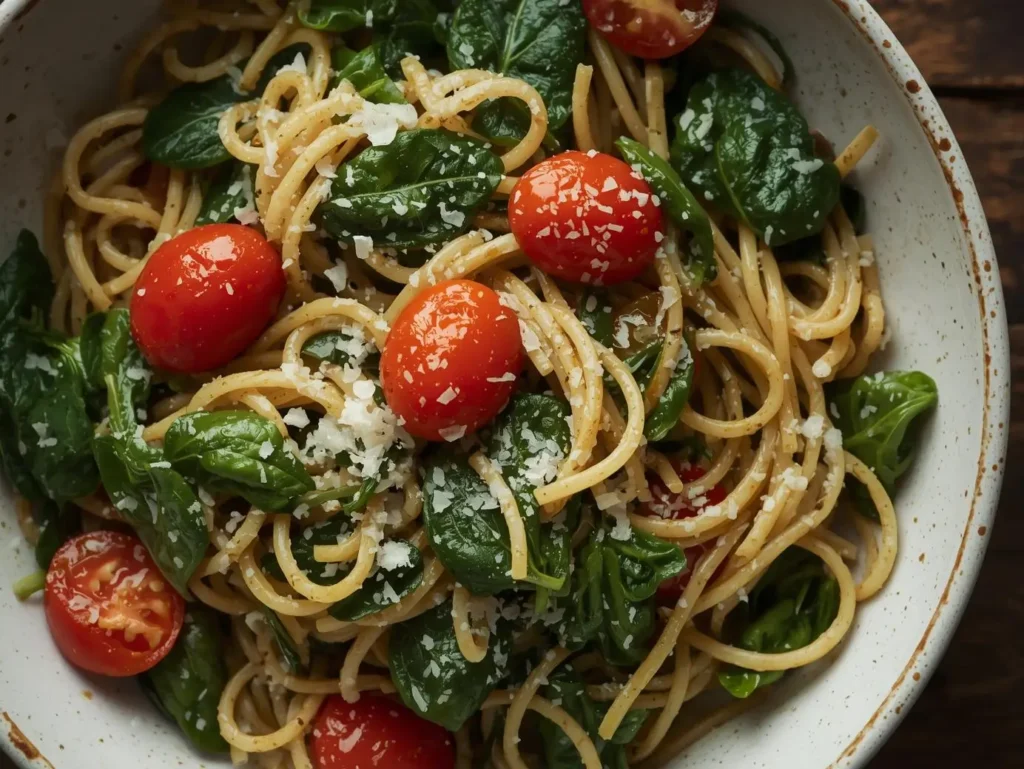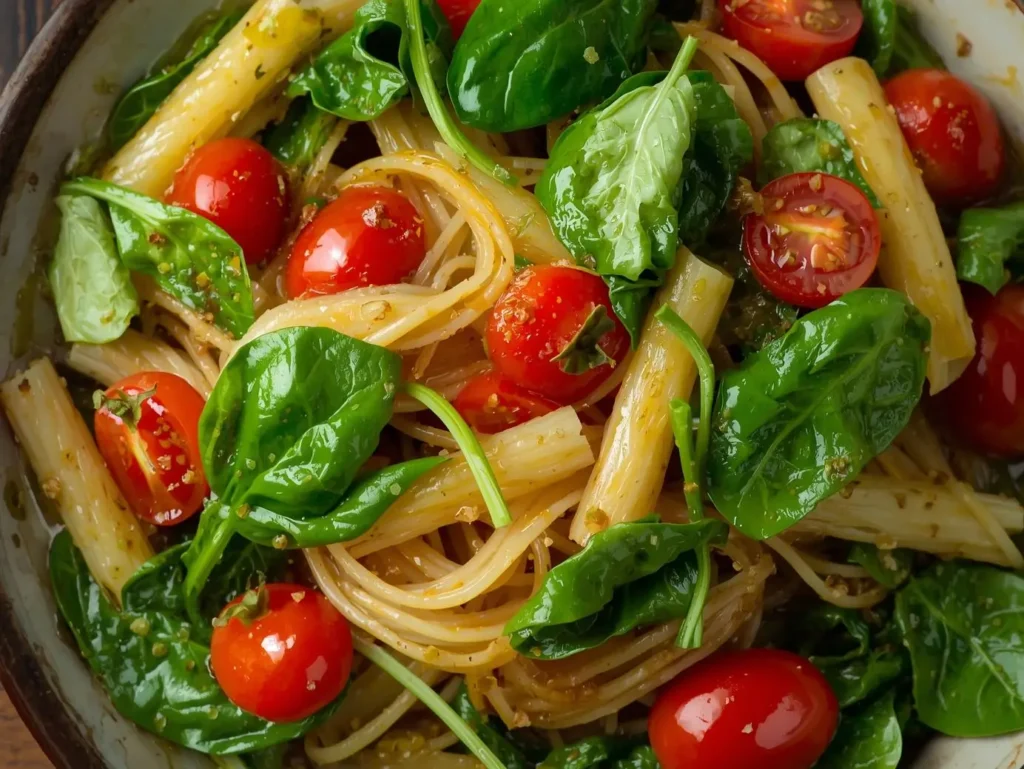Is it possible to enjoy a restaurant-worthy pasta dish that’s both nutritious and packed with flavor in less than 30 minutes?
Many believe that a satisfying pasta meal must involve creamy sauces or copious amounts of cheese, often leaving leafy greens and tomatoes as mere garnishes. Yet, the combination of spinach and tomato offers a textural and nutritional balance that challenges conventional wisdom. Spinach tomato pasta is not only a nutrient-dense choice but also a favorite among foodies searching for heart-healthy, plant-based dinners. The fusion of fresh spinach and ripe tomatoes creates a naturally creamy and tangy sauce that adheres perfectly to each strand of pasta. With spinach tomato pasta, you aren’t just eating another quick dinner; you’re tapping into a powerhouse of antioxidants, vitamins, and utterly bright, inviting flavors.
Let’s discover how to create this savory and vibrant meal, ensuring every bite supports both your palate and well-being.
Ingredients List
The beauty of spinach tomato pasta lies in its simplicity and adaptability. Using high-quality ingredients will elevate your meal from comforting to crave-worthy. If you’re missing something, creative swaps ensure that delight never takes a pause.
Core Ingredients
- Pasta (8 oz) – Spaghetti, penne, or fusilli work equally well. Choose whole wheat or gluten-free if preferred.
- Baby spinach (5 oz, about 5 packed cups) – Washed and ready to go.
- Cherry tomatoes (2 cups, halved) – Brings bursts of sweetness and acidity.
- Olive oil (2 tbsp) – Extra virgin for fruity richness.
- Garlic (4 cloves, minced) – Builds fragrant complexity.
- Onion (1 small, finely chopped) – Sweet undertones.
- Salt & pepper – To taste; sea salt recommended.
- Red pepper flakes (½ tsp, optional) – Offers gentle heat.
- Fresh basil (a handful, torn) – Uplifts with herbaceous notes.
Optional Add-ons and Substitutions
- Swap spinach for Swiss chard, kale, or arugula if desired.
- Replace cherry tomatoes with canned diced tomatoes (drained) in a pinch.
- For added creaminess, stir in ¼ cup of ricotta or a splash of plant-based cream.
- Gluten-free pasta varieties work seamlessly, as do chickpea-based blends.
- Sun-dried tomatoes can amplify the tomato essence.
- Vegans might sprinkle nutritional yeast instead of parmesan at the end.
Sensory Enhancements
- A final drizzle of lemon juice adds bright acidity.
- Finish with shaved parmesan, toasted pine nuts, or a sprinkle of black pepper for added depth and crunch.
Timing
Good food rarely waits: here, home cooks can expect efficiency alongside satisfaction.
- Preparation time: 8 minutes (chopping, washing, and readying ingredients)
- Cooking time: 15 minutes (from sauté to simmer to serve)
- Total time: 23 minutes
Compared to traditional baked pasta, which hovers near 45 minutes, spinach tomato pasta slashes time by nearly 50%, making it one of the quickest pathways to a wholesome dinner.

Step-by-Step Instructions
1. Prep the Ingredients
Wash and halve the cherry tomatoes, mince the garlic, chop the onion, and measure all components. Having everything ready before the pan gets hot keeps the process smooth.
Chef’s tip: Stack spinach leaves and slice into ribbons for easier incorporation once cooking begins.
2. Boil the Pasta
Bring a large pot of salted water to a rolling boil. Add your pasta, following package directions for al dente texture. Reserve half a cup of pasta water, then drain. The starchy water will help your sauce cling better.
3. Sauté Aromatics
In a large skillet over medium heat, pour in the olive oil. Add onions and sauté for about 3 minutes or until translucent. Stir in the garlic and red pepper flakes. Let the aroma develop—around 1 more minute.
Pro tip: Avoid burning garlic; if it browns too quickly, reduce the heat.
4. Add Tomatoes
Toss in cherry tomatoes, seasoning with a touch of salt and pepper. Cook for about 4-5 minutes until they soften and begin to burst, releasing their natural juices. Press gently on tomatoes with the back of a spoon for a saucier finish.
5. Add Spinach
Pile the spinach into the skillet. It may seem like a lot, but it wilts rapidly. Stir until just wilted—a vibrant green is your cue to move ahead, usually about 2 minutes.
6. Bring It All Together
Add the drained pasta right into the skillet. Toss with the vegetables, adding a splash of reserved pasta water to create a lightly glossy sauce that coats every strand.
7. Finish with Freshness
Turn off the heat. Shower the dish with fresh basil and, if you like, a hit of lemon juice. Optional cheese or nutritional yeast can be sprinkled now for added savor.
Personal tip: Tossing the pasta directly in the skillet ensures every bite is infused with garlicky, tomato-rich flavor.
Nutritional Information
A single serving (based on a four-serving recipe) offers a balanced plate that supports both energy and wellness goals.
| Nutrient | Amount per Serving |
|---|---|
| Calories | 325 |
| Protein | 10g |
| Carbs | 61g |
| Fiber | 7g |
| Fat | 8g |
| Saturated Fat | 1g |
| Sodium | 170mg |
| Vitamin A | 104% DV |
| Vitamin C | 58% DV |
| Iron | 22% DV |
| Calcium | 13% DV |
- High in dietary fiber, supporting digestion and blood sugar control.
- Rich in antioxidants from spinach and tomatoes, fueling cellular protection.
- Naturally low in saturated fat, ideal for lighter eating goals.
Healthier Alternatives for the Recipe
Spinach tomato pasta adapts beautifully to diverse needs.
- Whole grain pasta: Increases fiber and micronutrients.
- Legume-based pasta: Boosts protein, perfect for plant-forward diners.
- Low-sodium: Use unsalted canned tomatoes or halve salt.
- Vegan: Use plant-based cheese or nutritional yeast instead of parmesan.
- Keto-friendly: Spiralized zucchini can replace traditional pasta for a low-carb twist.
- Protein bump: Add grilled chicken breast, garbanzo beans, or sautéed mushrooms for even greater satiety.
Experiment with adding flaxseed, chia seeds, or hemp hearts for a subtle textural difference and valuable omega-3s.
Serving Suggestions
Personal touches turn a simple dish into a memorable meal.
- Twirl onto shallow bowls, topping with a tangle of fresh herbs and a crack of black pepper.
- Pair with a crisp green salad drizzled in balsamic vinaigrette.
- Round out with warm, crusty focaccia or rustic whole grain bread.
- Pack leftovers in mason jars for quick lunches that don’t wilt by noon.
- For entertaining, serve tapas-style with Mediterrean antipasti—think marinated olives, roasted peppers, and artichokes.
If you’re feeling ambitious, scatter pine nuts or microgreens over each portion as an elevated finishing flourish.
Common Mistakes to Avoid
Harness your inner chef by steering clear of the pitfalls below.
- Overcooking pasta: Leads to soggy strands that won’t hold up in sauce.
- Neglecting to reserve pasta water: Missing out on the secret to a glossy, restaurant-quality finish.
- Using bland tomatoes: Out-of-season or underripe tomatoes compromise flavor; opt for canned San Marzano if needed.
- Adding spinach too early: Overcooking leads to limp, colorless leaves. Wilt only at the end.
- Overcrowding the skillet: Limits the ability to sauté properly, resulting in uneven textures.
Resist the urge to drown the dish in cheese; let the natural sweetness and acidity shine.
Storing Tips for the Recipe
Proper storage means you’ll enjoy delicious flavors even after a busy workday.
- Store leftovers in an airtight container in the refrigerator for up to 3 days.
- For meal prep, keep the sauce (spinach and tomato mixture) and pasta separate. Combine just before eating to prevent sogginess.
- To reheat, add a splash of water or extra olive oil to restore lost moisture when warming in the microwave or on the stovetop.
- Freezing is not recommended, as spinach can take on a less desirable texture, but tomato sauce alone freezes well for future use.
Batch-cooking the sauce can cut dinner time in half during hectic weeks.
Conclusion
Spinach tomato pasta blends vibrant health benefits with irresistible flavor, all in a fraction of the time required for fussier dishes. Try this recipe, share your experience in the review section or comment below, and be sure to subscribe for more nourishing ideas.
FAQs
Can I use frozen spinach instead of fresh?
Yes, just thaw and squeeze out excess moisture before adding it to the skillet.
What pasta shapes are best for spinach tomato pasta?
Short shapes like penne and fusilli hold sauces well, while spaghetti provides a classic feel. Any preferred shape will do the trick.
Is there a way to make it kid-friendly?
Keep red pepper flakes minimal, and consider stirring in a tablespoon of cream cheese for extra creaminess.
Can I make this dish gluten-free?
Absolutely! Opt for gluten-free pasta or legume-based options. All other ingredients are naturally gluten-free.
How do I prevent the pasta from clumping together?
Toss the cooked pasta with a little olive oil if not using immediately, and ensure you add it directly into the pan with veggies and sauce for full coating.
If you crave more healthy, easy pasta ideas, explore the related recipes below or reach out with questions—your creativity keeps our kitchen inspired.


